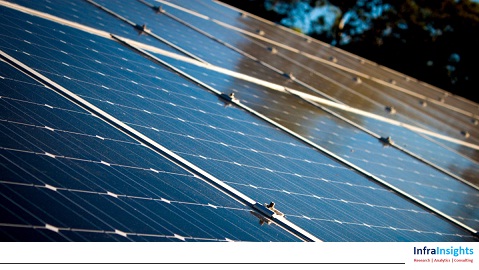The capacity created in India’s renewable energy sector may be impressive, but the pace has begun to slacken. Solar capacity installations in the country is at 25,000 megawatts (MW), or one-fourth of the 2022 target of 100,000 MW and it will require to grow at 35-40% CAGR over next 3 years to achieve the 100,000 MW target. Cleary there are signs of exhaustion, Energy infrastructure constraints are also making developers wary. Last month, the Solar Energy Corp. of India had cancelled a 2,000 MW tender after it was under-subscribed due to insufficient transmission infrastructure, many analyst have started downgrading the overall projected capacity addition outlook targets. Government actions, such as imposition of import duty, cancellation of tenders (in solar) and proposal to cap tariffs, have hit investor sentiment. As a consequence, the cost of capital is rising as investors are factoring in more risks and project returns have fallen to low teens tracking the steady drop in tariffs. On other side, discoms are making every attempt to put spanner in the growth of solar, for instance, rattled by the exodus of its consumers towards solar generation, MSEDCL after seeking a surcharge of Rs. 1.26 per unit on such consumers, has also proposed to replace net metering by gross metering. Gross metering will make solar roof top unviable. |
InfraInsights has been writing report in all sub-sector within energy & infrastructure sector, except solar, and we have been bombarded with questions on why we don’t and what are our view points on the subject. InfraInsights has been consistently providing its view point on the subject, which apparently don’t find many takers, as our views were always contrarian to euphoric view provided by one and all. Overall, we are cautiously optimistic, and hold strong view that future of solar is solar roof-top and key architect of this future will be power consumers; In 2012, InfraInsights pre-empted that solar roof-top will emerge bigger component than utility scale solar. InfraInsights is of the strong view that, solar’s true potential can be harnessed in decentralized, micro grid model. Solar is currently a push based or sellers’ market, wherein government agenda is delivered by pushing Discoms to buy costly solar power, irrespective of their financial health. So, what prompted us to jump into this solar Euphoria? |
India’s solar dream of building 100 gigawatts (GW) of capacity by 2022 continues to garner massive interest from global investors, buoyed by the promise of strong returns. But it also faces financing challenges as investors become more cautious amid a fall in solar energy tariffs. InfraInsights research report” Solar Power Likely to get Eclipsed: Next Wave of NPA in Power Sector Coming Soon!, a Bubble about to burst, like Italy or Germany?” by no means intents to play a spoil sport but attempts to unearth the reality from optics, so that investors doesn’t face a situation as faced in developed markets like Spain. |
- Executive Summary
- Approach & Methodology
- Solar Power in India – Sunrise to Sunshine Journey
- Growth in Solar Capacity Addition
- Solar Capex & Solar Industrialization
- Enabling Policy
- Challenges & Hurdles Weathered
- Solar Power Penetration Levels across different states in India
- State wise solar power capacity addition
- Solar power component in overall power supply basket
- RPO Target Compliance % Vs Actuals
- Solar Power Generation across different states in India
- CUF Levels
- Trend in power generation
- Solar Power Generation Cost vs Feed in Tariffs across India
- Challenges faced by solar power developers in India
- Project Construction Related Challenges
- Land Acquisition
- Project Financing Related Challenges
- Credit Cost
- Viability Gap Funding
- Project Monetization Related Challenges
- Transmission Constrain
- Feed in Tariff
- Net Metering / Gross Metering
- Project Construction Related Challenges
- Key Success Stories & Failures in India’s Solar Power Sector
- Companies expanding solar foot print
- Success factors and what did they do differently
- Companies calling it quits in solar power sector
- Where did they burn their fingers and lessons learnt
- Companies expanding solar foot print
- Projected growth trajectory of solar in India
- InfraInsights critical analysis of likely realization levels against target
- Utility Scale Solar vs Roof Top Solar Projects
- Successes
- Failures
- Factors that weighs heavily on the solar sector
- Discoms financial health
- Discoms not keen on buying solar from roof-top
- Discoms not complying by RPO norms
- Transmission constraint
- Pricing under pressure
- Project IRRs becoming near negligible
- Check for Signs of Exhaustion
- Solar Power Capacity Addition
- Underlying growth in solar power consumption
- Policy becoming less accommodative
- Banks becoming stringent in lending to solar sector
- Consumers of solar power
- Solar power buyer profiling – beyond discoms
- 2017-18 solar power sales / consumption segmentation by end user
- Will Evization of mobility landscape be a game changer for solar power sector in India?
- NPA risks looms large – a close look
- Detailed interviews of solar power projects across country to ascertain financial health of a project
- M&A trend
- Bankers view on potential NPA risk in Solar Power Sector
- Cases of NPA in solar
- Projected cases of NPA
- InfraInsights framework on identifying projects in solar that are likely to fail
- Location of project
- Project type – solar roof top vs utility scale
- Buyer profile – discoms, exchange, rec’s etc
- Cost vs tariff / realization
- CUF actual Vs CUF estimate during project appraisal
- Detailed profiling of projects that are likely to be up for sale
- Promoter profile
- Core businesses
- Solar portfolio
- Recent expansion vs exits
- Stakeholding analysis
 We create value for our customers by amalgamating deep functional and energy industry expertise. Our solutions range from in depth research reports to advisory services enabling our customers with energy market insights to take informed decisions, grow and improve on their competitiveness.
Leveraging our breadth of geographical reach we provide solutions in entire energy value chain be it coal, power, oil and gas or renewable. We are a reliable and efficient source comprising of best in class talent pool which provides answer to all the challenges of the energy industry
We create value for our customers by amalgamating deep functional and energy industry expertise. Our solutions range from in depth research reports to advisory services enabling our customers with energy market insights to take informed decisions, grow and improve on their competitiveness.
Leveraging our breadth of geographical reach we provide solutions in entire energy value chain be it coal, power, oil and gas or renewable. We are a reliable and efficient source comprising of best in class talent pool which provides answer to all the challenges of the energy industry



